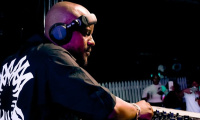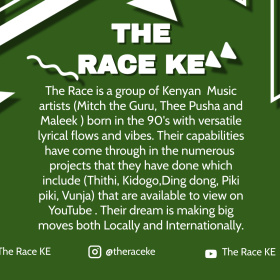Gospel music in Nigeria
Broadly, the gospel genre originated from a fusion of traditional Christian hymns as performed by church choirs. This was first formally documented in the late 19th century in the USA. This fusion was crystallised in the 1930s by the work of pioneer gospel artiste, Thomas Dorsey, a jazz pianist, who combined choral compositions with blues and jazz. The fusion, called gospel blues, evolved into the more contemporary forms of gospel music, with the infusion of soul and rhythm and blues pioneered by James Cleveland, who recorded the first gospel album in 1954, and others like female singers Mahalia Jackson and Albertina Walker.
 TY Bello
TY Bello
Origins
Christian music in Nigeria was first introduced in the 16th century by Portuguese catholic missionaries to Benin and Warri through a rudimentary form of Portuguese liturgical music during the early evangelisation of those kingdoms between 1485 and 1600. However, it was not until the mid-nineteenth century, with the robust missionary activities of the UK based Church Missionary Society (CMS), that wide-spread evangelisation occurred across what was to become Nigeria. The CMS Church introduced the choral music of the Anglican Church, which largely involved congregational singing.
The pioneer of a uniquely Nigerian variant of choral music, was the Reverend Josiah J. Ransome-Kuti, who began experimenting with the fusion of choral music with Yoruba language and melodic structures in the 1890s. He composed choral pieces, as church organist of the St Peters Church, Ake, Abeokuta, embodying the language and style of the Yoruba people. His work was so recognised that he was invited to the United Kingdom in 1922 to record an album of these compositions on the Zonophone label. A total of 43 tracks were recorded and some of these became standards, such as ‘Egbe awon angeli’, ‘Oyigi yigi olorun wa’, ‘Jesu oba alaanu’. He was the first West African to record an album.
Ransome-Kuti (grand-father of Fela Anikulapo-Kuti) can thus be said to be the father of Nigerian gospel music, as far as the genre is defined as a fusion of Christian hymnal music and other genres. In this instance, African traditional music. Kuti’s work may have been original and distinct from the parallel evolution of gospel music in the USA.
The other influential personality in the growth of gospel music in the early 20th century was chorister and composer Ikoli Harcourt-Whyte, who was the first person to compose Christian Choral music in the Igbo language of South-eastern Nigeria. He began his experimentation with both forms in the 1930s and was inspired by his time as a patient at the Methodist Leprosy Colony, Uzuakoli in Eastern Nigeria. His compositions became, as with Ransome-Kuti before him, gospel standards in Igbo-land, totalling over 200. While he did not record an album, his compositions were recorded by the Choir of the Leprosy Colony, Uzuakoli, after his death in 1977. A second recording was done in the US by the St. Louis Missouri African Choir in 1999.
Growth and Evolution (1930-1969)
Ransome-Kuti and Harcourt-Whyte became the models for several generations of Nigerian gospel musicians, as gospel hymns in various languages evolved with church services in indigenous languages. As was originally intended by Ransome-Kuti, these services became a key element in the evangelical drive. In the 1950s and 1960s a number of independent Churches emerged, with an indigenously influenced order of service: the Cherubim and Seraphim Church, Celestial Church of Christ (founded 1947) and the Qua Iboe Church (founded 1887).
The C&S Church, though founded in 1925 by the former CMS member Moses Orimolade Tunolashe, developed strict indigenous influences, such as the adoption of Yoruba language, and Yoruba traditional music as its hymnal form. Founded by Irish Missionaries in the 1887, Qua Iboe later adopted the Efik language and elements of traditional Efik music in its hymnal and choral renditions.
This trend of combining traditional music forms and choral music became hugely wide-spread across Nigeria, with older churches like the CMS, Catholic and Anglican incorporating African traditional instruments into the backing music of their choral renditions, the most prominent being the rhythm of traditional drums and the Bass Calabash (Udu) in Eastern Nigeria.
The 1970s-1980s
By the beginning of the 1970s, changes influenced by American gospel music, especially folk gospel and country gospel, began to be felt in Nigeria, with stars like Jim Reeves, Johnny Cash commanding a large following. Their occasional forays into gospel influenced a new generation of contemporary Nigerian Christian musicians. One of the first Nigerian bands to revolutionise this sub-genre was the Karis Band of the University of Nigeria, Nsukka. The Pentecostal movement was taking root with active evangelism from the USA and this band was formed by members of the Scripture Union (SU), one of the most active Pentecostal groups at the time. The SU promoted evangelism through the use of joyous, lively contemporary music, in what was described as the “praise and worship” format. As in the time of Rev. Ransome-Kuti, this was to encourage converts to participate.
Other Pentecostal groups emerged with the same format, and thus emerged a generation of popular gospel musicians across the country in the 1970s. These included the Voice of the Cross, featuring the duo Brothers Lazarus and Emmanuel from Eastern Nigeria, whose album Jua onwe gi aju featured as session musicians, funk band the Friimen. From Western Nigeria came Evangelist Bola Are and notably, the Good Women Choir of the Christ Apostolic Church. The latter was also distinct in promoting a fully professional Classical Orchestra, featuring a full string octet and a harpist. A number of secular musicians, however, tapped into this trend in the late 1960s and early 1970’s, releasing gospel-oriented singles, while retaining secular status. Two examples being juju music star Ebenezer Obey with his 'Gbebe mi' (1968) and soul singer Joe Nez with his 'Agame bu ahaya elu' (1976).
By the 1980s the gospel music revolution was in full swing, with a plethora of bands emerging across the country in response to the now exponential spread of the Pentecostal movement. This coincided with the conversion of a number of popular secular music stars, of which the most notable were pop-crooner Kris Okotie and platinum-selling Sunny Okosuns. From Northern Nigeria emerged the soft and gentle tones of Panam Percy Paul, with the album Bring Down the Glory (1987).
The 1990s
The growth of the gospel genre continued in this decade. A new generation of American stars had emerged in gospel music, such as Kirk Franklin, The Winans, Ron Kenoly. Their influence travelled across the Atlantic. And this influence manifested with the emergence of a new generation of talents modelled on their heroes, such as singers Kingsley Ike, Onos Brisibe, Sam Okposo, Broda Martyns, Ese Agese and many others. The transition of secular superstars to gospel music continued. Ebenezer Obey, switched wholly in 1992. Others include, Onyeka Onwenu, falsetto voiced pop sensation, Dizzy K Falola, afro soul artist Akeeb Kareem.
A new sub-genre emerged. Gospel Jazz, with a generation of talented instrumentalists found a global stage. Some of these included guitarists Kunle Odutayo (Kunle Ayo), Agboola Shadare and Laja Adeyemo; bassists Bright Gain and Michael Olatuja; saxophonists Mike Aremu, Kunle Ajayi and Kenny Sagay; as well as trumpeter and musicologist (and Music In Africa contributing writer) Biodun Benjamin Adebiyi. These artistes established themselves as highly respected, sellable acts, travelling the world as evangelical ministers, while exhibiting high quality musicianship.
Some traditional choral groups also found prominence in this decade, notably the Nkwa Group of the Assemblies of God Church, with its album Chi ga eji chi ga bo, as well as the Good Women Choir, which released several successful albums throughout the decade. A new generation of choirs sprung up, like the House on the Rock Choir, conducted at a time by Sam Okposo, and the Fountain of Life Choir.
2000-present
By the new millennium, gospel music had established itself as an important genre. Churches provided the most readily available training ground for young musicians without the funds to invest in expensive instruments. Additionally, with the continued spread of the Pentecostal movement, the demand for new gospel bands meant employment and income
Additionally, gospel music concerts emerged, sponsored by successful churches and ministries. International stars performed alongside Nigerian ones. The era brought out TY Bello, Nikki Laoye, Yinka Ayefele, rapper Bouqui, Lanre Teriba and Onyedikachi Umeh.
Gospel music in Nigeria evolved from its rudimentary, obscure, renaissance period origins, through to the Victorian era. In the 20th century, Nigerian gospel music acquired a character, based, not on wholesale imitation of the dominant driving force of American gospel music, but on a largely indigenous hybrid driven by the needs of its audience. This changed in the 1970s when it succumbed to the influence of popular music. From this grew a substantial musical industry, which employs Nigerian musicians.
The expansion of the evangelical movement and Pentecostal activity in Nigeria continues to point to gospel music as crucial pillar of the Nigerian music industry.
Further reading:
Boyer, Horace. 1995. The Golden Age of Gospel. Echeruo, Michael. 1977. Victorian Lagos. Egharevba, Jacob. 1934. A short history of Benin.Hackett, R.I. and B.F.Soares. 2015. New Media and Religious transformations in Africa.
Keazor, Ed. 2015. 120 greatest Nigerians we never knew. Keazor, Ed. 2015. The history of Nigerian Jazz Music. Omojola, Bode. 1995. Nigerian art music: with an introductory study of Ghanaian art music. Soyinka, Wole. Ake, the Early Years.





























Comments
Log in or register to post comments